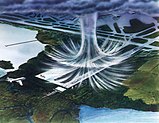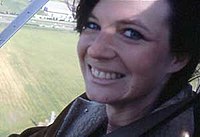Portal:Aviation
| Main page | Categories & Main topics |
|
Tasks and Projects |
The Aviation Portal

Aviation includes the activities surrounding mechanical flight and the aircraft industry. Aircraft includes fixed-wing and rotary-wing types, morphable wings, wing-less lifting bodies, as well as lighter-than-air craft such as hot air balloons and airships.
Aviation began in the 18th century with the development of the hot air balloon, an apparatus capable of atmospheric displacement through buoyancy. Some of the most significant advancements in aviation technology came with the controlled gliding flying of Otto Lilienthal in 1896; then a large step in significance came with the construction of the first powered airplane by the Wright brothers in the early 1900s. Since that time, aviation has been technologically revolutionized by the introduction of the jet which permitted a major form of transport throughout the world. (Full article...)
Selected article
Wind shear itself is a microscale meteorological phenomenon occurring over a very small distance, but it can be associated with mesoscale or synoptic scale weather features such as squall lines and cold fronts. It is commonly observed near microbursts and downbursts caused by thunderstorms, weather fronts, areas of locally higher low level winds referred to as low level jets, near mountains, radiation inversions that occur due to clear skies and calm winds, buildings, wind turbines, and sailboats. Wind shear has a significant effect during take-off and landing of aircraft due to their effects on steering of the aircraft, and was a significant cause of aircraft accidents involving large loss of life within the United States.
Sound movement through the atmosphere is affected by wind shear, which can bend the wave front, causing sounds to be heard where they normally would not, or vice versa. Strong vertical wind shear within the troposphere also inhibits tropical cyclone development, but helps to organize individual thunderstorms into living longer life cycles which can then produce severe weather. The thermal wind concept explains with how differences in wind speed with height are dependent on horizontal temperature differences, and explains the existence of the jet stream. (Full article...)
Selected image
Did you know
...that Astro Flight, Incorporated of Marina del Rey, California created the world's first practical electric-powered radio controlled model airplane and the world's first full-scale solar-powered airplane? ...that the Tenerife disaster remained the deadliest aircraft incident in history until the September 11, 2001 attacks and neither plane was in flight when the accident occurred. ... that while flying accidents were commonplace at RAAF training establishments during World War II, No. 8 Service Flying Training School's first fatality was from drowning?
General images -
In the news
- May 29: Austrian Airlines cancels Moscow-bound flight after Russia refuses a reroute outside Belarusian airspace
- August 8: Passenger flight crashes upon landing at Calicut airport in India
- June 4: Power firm helicopter strikes cables, crashes near Fairfield, California
- January 29: Former basketball player Kobe Bryant dies in helicopter crash, aged 41
- January 13: Iran admits downing Ukrainian jet, cites 'human error'
- January 10: Fire erupts in parking structure at Sola Airport, Norway
- October 27: US announces restrictions on flying to Cuba
- October 3: World War II era plane crashes in Connecticut, US, killing at least seven
- September 10: Nevada prop plane crash near Las Vegas leaves two dead, three injured
- August 6: French inventor Franky Zapata successfully crosses English Channel on jet-powered hoverboard
Related portals
Associated Wikimedia
The following Wikimedia Foundation sister projects provide more on this subject:
-
Commons
Free media repository -
Wikibooks
Free textbooks and manuals -
Wikidata
Free knowledge base -
Wikinews
Free-content news -
Wikiquote
Collection of quotations -
Wikisource
Free-content library -
Wikiversity
Free learning tools -
Wikivoyage
Free travel guide -
Wiktionary
Dictionary and thesaurus
Selected biography
Despite her surname, Jeana Yeager is not related to Chuck Yeager, the first man to break the sound barrier in level flight.
Selected Aircraft

The Airbus A380 is a double-deck, four-engined airliner manufactured by Airbus S.A.S. It first flew on 27 April 2005 from Toulouse–Blagnac Airport. Commercial flights began in late 2007 after months of testing, with the delivery of the first aircraft to launch customer Singapore Airlines. During much of its development phase, the aircraft was known as the Airbus A3XX, and the nickname Superjumbo has also become associated with the A380.
The A380 is double decked, with the upper deck extending along the entire length of the fuselage. This allows for a spacious cabin, with the A380 in standard three-class configuration to seat 555 people, up to maximum of 853 in full economy class configuration. Only one model of the A380 was available: The A380-800, the passenger model. It is the largest passenger airliner in the world superseding the Boeing 747. The other launch model, the A380-800F freighter, was canceled and did not join the ranks of the largest freight aircraft such as the Antonov An-225, An-124, and the C-5 Galaxy.
- Span: 79.8 m (261 ft 10 in)
- Length: 73 m (239 ft 6 in)
- Height: 24.1 m (79 ft 1 in)
- Engines: 4 * Rolls-Royce Trent 900 or Engine Alliance GP7200 (311 kN or 69,916 lbf)
- Cruising Speed: 0.85 Mach (approx 1,050 km/h or 652 mph or 567 kn)
- First Flight: 27 April 2005
- Number built: 254 (including 3 prototypes)
Today in Aviation
- 2009 – Bangkok Airways Flight 266, an ATR 72-200 carrying 68 passengers crashes in severe weather on landing at Samui airport in the resort island of Ko Samui in Thailand, resulting in at least 1 confirmed death and 37 injuries.
- 2007 – NASA’s Phoenix spacecraft launches from Cape Canaveral, en route to a landing on Mars which would take place on May 25th, 2008.
- 2007 – A suitcase containing US$800,000 in undeclared cash is discovered while being x-rayed at Aeroparque Jorge Newbery in Buenos Aires, sparking an international rift between Argentina and Venezuela known as “Maletinazo, ” or “the suitcase incident. ”
- 1992 – An Lockheed F-117A Nighthawk, 85-801, "The Perpetrator", goes out of control after take off for a night training mission from Holloman AFB, New Mexico. Pilot Capt. John B. Mills of the 416th Fighter Squadron, ejects safely, suffering only minor cuts. Airframe comes down in sparsely populated area near a trailer park. Investigators believed that an improperly-reinstalled bleed air duct led to control failure.
- 1973 – First of two prototype Boeing YQM-94A Compass Cope B long-range remotely piloted vehicles (RPV), possibly serial 70-1839, crashed during its second test flight. The USAF decides not to order the Compass Copes into production. Second prototype is now on display at the National Museum of the United States Air Force, Dayton, Ohio.
- 1971 – First flight of the AgustaWestland AW109
- 1959 – The first medical evacuation by helicopter from a Mobile Army Surgery Hospital (MASH) team takes place when an S-51 helicopter flies out a casualty from a fire flight along the Pusan Perimeter.
- 1954 – First flight of the English Electric Lightning P.1A.
- 1952 – Off Korea, the explosion of an aircraft fuel tank causes a fire on the flight deck of the U. S. Navy aircraft carrier USS Boxer (CV-21) which kills nine and injures 30 men and destroys or damages 18 aircraft.
- 1943 – North American XB-28A-NA, 40-3058, c/n 67-3417, crashes into the Pacific Ocean off California after the crew bails out. Project not proceeded with.
- 1943 – F/L AA Bishop and crew in a Short Sunderland of No. 423 Squadron sank the German submarine U-489. The Sunderland was shot down; five crew were lost and six saved.
- 1943 – The U. S. Army Air Forces’ Eleventh Air Force flies 135 sorties against Kiska in the Aleutian Islands, dropping 304,000 pounds (137,893 kg) of bombs.
- 1943 – German aircraft again attack the harbor at Palermo, damaging the American destroyer USS Shubrick (DD-639).
- 1929 – 4-16 – The first International Tourist Aircraft Contest Challenge 1929 in Paris, with 5,942 km race over Europe, won by the German crew of Fritz Morzik on the BFW M.23 plane.
- 1924 – The attempt of the Royal Air Force team of MacLaren, Plenderleith, and Andrews to circumnavigate the world eastbound ends when they are forced down in the Bering Sea by fog and their Vickers Vulture amphibian is irreparably damaged. They taxi to safety at Bering Island in the Commander Islands. They had covered 13,100 miles (21,095 km) in 130 days.
- 1914 – The United Kingdom enters World War I, declaring war on Germany.
- 1908 – Wilbur Wright makes the first flight using stick controls near Le Mans, France. The flight lasts 1 min and 45 seconds.
- 1908 – Count von Zeppelin takes the LZ4 on a 24-hour flight from Lake Constance, down the Rhine to Basel, then to Strasbourg and Mainz and back to Stuttgart, a total non-stop distance of 435 miles.
- 1901 – Octave Chanute arrives at the Wright brothers’ camp at Kill Devil Hill and photographs their flight tests with the 1901 glider.
- 1807 – Andre-Jacques Garnerin in Paris, France makes the first night ascent in a balloon.
References
- Shortcuts to this page: Portal:Airplanes • P:AVIA





















































